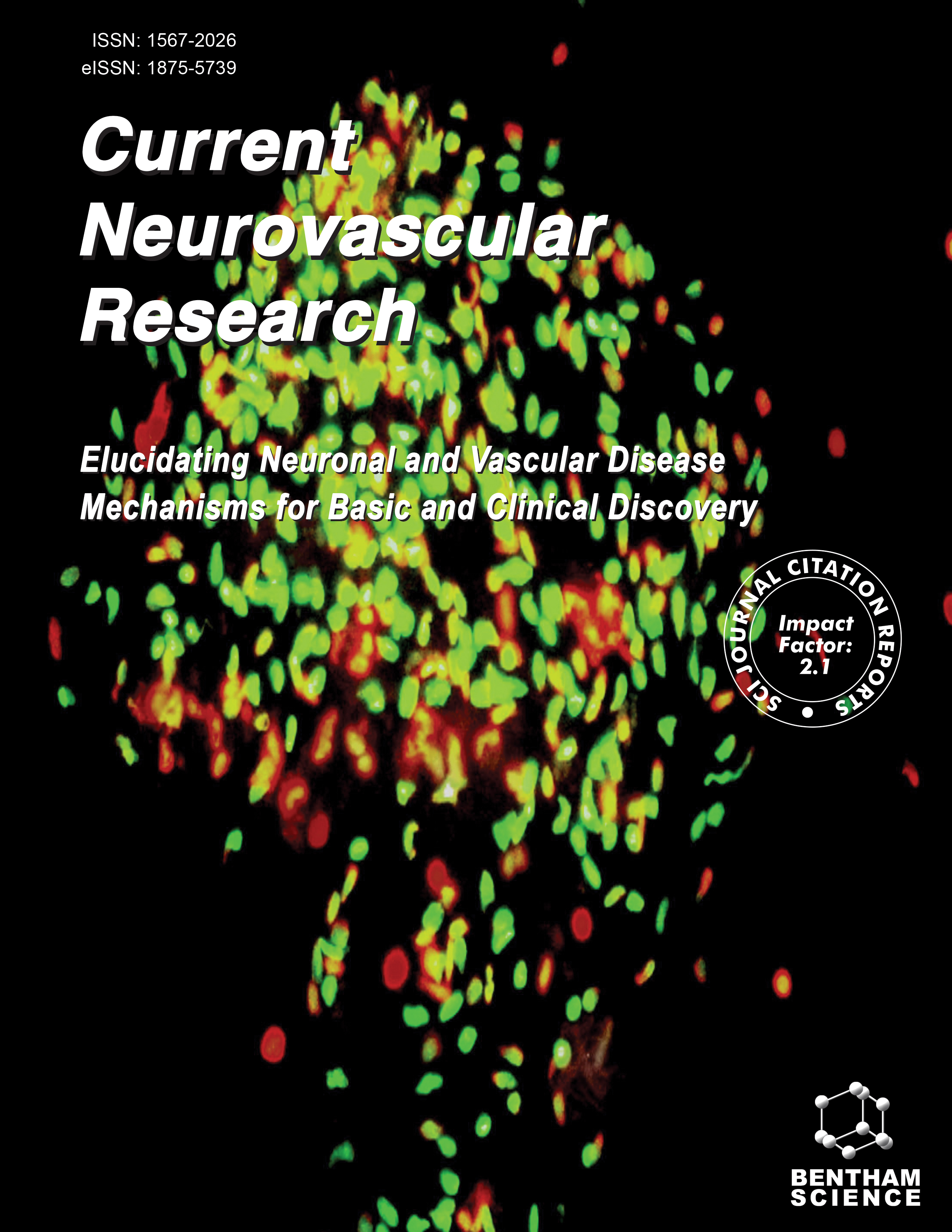- Home
- A-Z Publications
- Current Neurovascular Research
- Previous Issues
- Volume 7, Issue 3, 2010
Current Neurovascular Research - Volume 7, Issue 3, 2010
Volume 7, Issue 3, 2010
-
-
Intravenous Implanted Neural Stem Cells Migrate to Injury Site, Reduce Infarct Volume, and Improve Behavior after Cerebral Ischemia
More LessAuthors: Chiung-Chyi Shen, Chen-Huan Lin, Yi-Chin Yang, Ming-Tsang Chiao, Wen-Yu Cheng and Jiunn-Liang KoStroke represents one of the leading causes of death and disability in humans, but despite intense research, only a few options exist for the treatment of stroke-related infarction of brain tissue. Thus far, in experimental strokes, cell therapy appears to partly reverse some behavioral deficits. However, the mechanisms of action remain uncertain as most studies reveal only little, if any, evidence for neuronal replaceme Read More
-
-
-
Pitavastatin and 4'-Hydroxy-3'-Methoxyacetophenone (HMAP) Reduce Cognitive Dysfunction in Vascular Dementia During Experimental Diabetes
More LessAuthors: Bhupesh Sharma and Nirmal SinghDiabetes has been found to increase the probability of vascular dementia in humans. We have investigated the effect of 4'-hydroxy-3'-methoxyacetophenone (HMAP), a NADPH oxidase inhibitor and Pitavastatin, a HMG Co-A reductase inhibitor, on Streptozotocin (STZ) diabetes induced vascular dementia in rats. Donepezil served as a positive control. The rats were administered with single dose of STZ for the ind Read More
-
-
-
Homocysteine Enhances Transmigration of Rat Monocytes through a Brain Capillary Endothelial Cell Monolayer via ICAM-1
More LessAuthors: Lindsay A. Hohsfield and Christian HumpelIncreased homocysteine (Hcy) levels contribute to a variety of cardiovascular and cerebrovascular diseases including stroke and Alzheimer's disease. Recent data has shown that elevated levels of Hcy can lead to blood-brain barrier (BBB) dysfunction and activation. However, the mechanism for Hcy-mediated dysfunction remains unclear. The aim of this study is to characterize the effects of moderate Hcy administ Read More
-
-
-
Endogenous Agmatine Inhibits Cerebral Vascular Matrix Metalloproteinases Expression by Regulating Activating Transcription Factor 3 and Endothelial Nitric Oxide Synthesis
More LessAuthors: Hyun Joo Jung, Mei Zi Yang, Ki Hyo Kwon, Midori A. Yenari, Yoon Jung Choi, Won Taek Lee, Kyung Ah Park and Jong Eun LeeEarlier investigations from our laboratory demonstrated that the expression of matrix metalloproteinases (MMPs) was down-regulated by exogenously administered agmatine against ischemia-like injuries in the murine brain capillary endothelial (bEnd.3) cells. In our present study, we intended to investigate the mechanism involved in the inhibition of MMPs in bEnd.3 cells infected with retroviral containing human argini Read More
-
-
-
Angelica Injection Promotes Peripheral Nerve Structure and Function Recovery with Increased Expressions of Nerve Growth Factor and Brain Derived Neurotrophic Factor in Diabetic Rats
More LessAuthors: Ruilin Li, Junjian Zhang, Lei Zhang, Qin Cui and Hui LiuSeveral nervous system injury models, such as sciatic crush and chronic cerebral hypoperfusion have been well studied in terms of neuroprotective effect of angelica injection. However, definitive experimental studies are lacking on diabetic peripheral neuropathy (DPN). This study sought to investigate the effects of angelica injection on DPN in type 1 diabetic rats. Diabetes was induced by single intraperitoneal injection of str Read More
-
-
-
Leptin and Interleukin-1β Modulate Neuronal Glutamate Release and Protect Against Glucose-Oxygen-Serum Deprivation
More LessAuthors: Chen-Hsuan Wang, Wei-Ti Wang, Shu-Yun Cheng, Wan-Ting Hung, Tzu-Lien Wu and Chi-Mei HsuehMolecular mechanism underlying leptin-mediated neuronal protection against glucose-oxygen-serum deprivation (GOSD) insult was investigated by focusing on the interactions among leptin, Interleukin-1β (IL-1β) and glutamate and their impacts on the growth of neurons under GOSD. The trypan blue dye exclusion assay, 4', 6-diamidino- 2-phenylindole (DAPI) assay, cytokine antibody array assay, immunocytochemical staini Read More
-
-
-
Spinal Microvascular Expression of PV-1 is Associated with Inflammation, Perivascular Astrocyte Loss, and Diminished EC Glucose Transport Potential in Acute SCI
More LessAuthors: Anthony B. Mozer, Scott R. Whittemore and Richard L. BentonThe endothelial-specific expression of plasmalemmal vesicle associated protein-1 (PV-1) is typical of fenestrated endothelium observed in pulmonary capillaries and some endocrine organs. In the central nervous system (CNS) it is expressed during development but disappears concomitant with maturation of the blood-CNS barrier [1]. Consistent with observations made in models of stroke, Alzheimer's disease, a Read More
-
-
-
Pathophysiology of the Vascular Wall and its Relevance for Cerebrovascular Disorders in Aged Rodents
More LessChronic hypertension and cerebral amyloid angiopathy (CAA) are the main pathologies which can induce the rupture of cerebral vessels and intracerebral hemorrhagies, as a result of degenerative changes in the vascular wall. A lot of progress has been made in this direction since the successful creation of the first mouse model for the study of Alzheimer's disease (AD), as the spectrum of AD pathology includes a pleth Read More
-
Volumes & issues
-
Volume 21 (2024)
-
Volume 20 (2023)
-
Volume 19 (2022)
-
Volume 18 (2021)
-
Volume 17 (2020)
-
Volume 16 (2019)
-
Volume 15 (2018)
-
Volume 14 (2017)
-
Volume 13 (2016)
-
Volume 12 (2015)
-
Volume 11 (2014)
-
Volume 10 (2013)
-
Volume 9 (2012)
-
Volume 8 (2011)
-
Volume 7 (2010)
-
Volume 6 (2009)
-
Volume 5 (2008)
-
Volume 4 (2007)
-
Volume 3 (2006)
-
Volume 2 (2005)
-
Volume 1 (2004)
Most Read This Month
Article
content/journals/cnr
Journal
10
5
false
en


